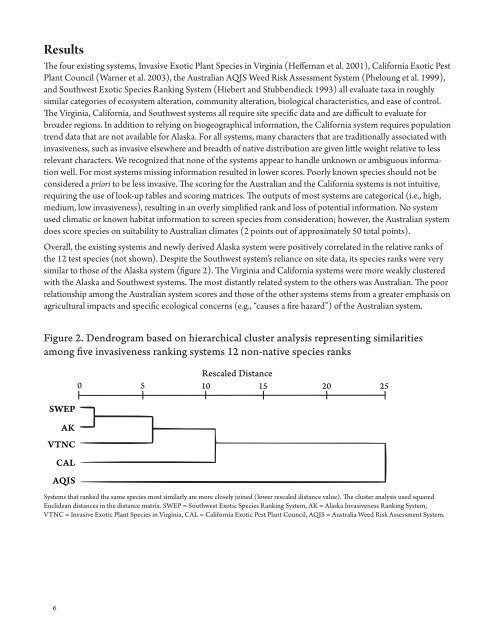Invasiveness Ranking System for Non-Native Plants of Alaska
Invasiveness Ranking System for Non-Native Plants of Alaska
Invasiveness Ranking System for Non-Native Plants of Alaska
You also want an ePaper? Increase the reach of your titles
YUMPU automatically turns print PDFs into web optimized ePapers that Google loves.
ResultsThe four existing systems, Invasive Exotic Plant Species in Virginia (Heffernan et al. 2001), Cali<strong>for</strong>nia Exotic PestPlant Council (Warner et al. 2003), the Australian AQIS Weed Risk Assessment <strong>System</strong> (Pheloung et al. 1999),and Southwest Exotic Species <strong>Ranking</strong> <strong>System</strong> (Hiebert and Stubbendieck 1993) all evaluate taxa in roughlysimilar categories <strong>of</strong> ecosystem alteration, community alteration, biological characteristics, and ease <strong>of</strong> control.The Virginia, Cali<strong>for</strong>nia, and Southwest systems all require site specific data and are difficult to evaluate <strong>for</strong>broader regions. In addition to relying on biogeographical in<strong>for</strong>mation, the Cali<strong>for</strong>nia system requires populationtrend data that are not available <strong>for</strong> <strong>Alaska</strong>. For all systems, many characters that are traditionally associated withinvasiveness, such as invasive elsewhere and breadth <strong>of</strong> native distribution are given little weight relative to lessrelevant characters. We recognized that none <strong>of</strong> the systems appear to handle unknown or ambiguous in<strong>for</strong>mationwell. For most systems missing in<strong>for</strong>mation resulted in lower scores. Poorly known species should not beconsidered a priori to be less invasive. The scoring <strong>for</strong> the Australian and the Cali<strong>for</strong>nia systems is not intuitive,requiring the use <strong>of</strong> look-up tables and scoring matrices. The outputs <strong>of</strong> most systems are categorical (i.e., high,medium, low invasiveness), resulting in an overly simplified rank and loss <strong>of</strong> potential in<strong>for</strong>mation. No systemused climatic or known habitat in<strong>for</strong>mation to screen species from consideration; however, the Australian systemdoes score species on suitability to Australian climates (2 points out <strong>of</strong> approximately 50 total points).Overall, the existing systems and newly derived <strong>Alaska</strong> system were positively correlated in the relative ranks <strong>of</strong>the 12 test species (not shown). Despite the Southwest system’s reliance on site data, its species ranks were verysimilar to those <strong>of</strong> the <strong>Alaska</strong> system (figure 2). The Virginia and Cali<strong>for</strong>nia systems were more weakly clusteredwith the <strong>Alaska</strong> and Southwest systems. The most distantly related system to the others was Australian. The poorrelationship among the Australian system scores and those <strong>of</strong> the other systems stems from a greater emphasis onagricultural impacts and specific ecological concerns (e.g., “causes a fire hazard”) <strong>of</strong> the Australian system.Figure 2. Dendrogram based on hierarchical cluster analysis representing similaritiesamong five invasiveness ranking systems 12 non-native species ranksSWEPAKVTNCCALAQISRescaled Distance0 5 10 15 20 25<strong>System</strong>s that ranked the same species most similarly are more closely joined (lower rescaled distance value). The cluster analysis used squaredEuclidean distances in the distance matrix. SWEP = Southwest Exotic Species <strong>Ranking</strong> <strong>System</strong>, AK = <strong>Alaska</strong> <strong>Invasiveness</strong> <strong>Ranking</strong> <strong>System</strong>,VTNC = Invasive Exotic Plant Species in Virginia, CAL = Cali<strong>for</strong>nia Exotic Pest Plant Council, AQIS = Australia Weed Risk Assessment <strong>System</strong>.6
















